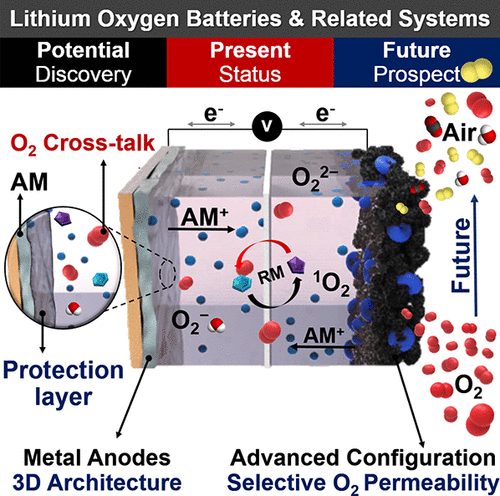当前位置:
X-MOL 学术
›
Chem. Rev.
›
论文详情
Our official English website, www.x-mol.net, welcomes your feedback! (Note: you will need to create a separate account there.)
Lithium-Oxygen Batteries and Related Systems: Potential, Status, and Future.
Chemical Reviews ( IF 62.1 ) Pub Date : 2020-03-05 , DOI: 10.1021/acs.chemrev.9b00609 Won-Jin Kwak 1, 2, 3 , Rosy 4, 5 , Daniel Sharon 6, 7 , Chun Xia 8 , Hun Kim 1 , Lee R Johnson 9 , Peter G Bruce 10 , Linda F Nazar 8 , Yang-Kook Sun 1 , Aryeh A Frimer 4 , Malachi Noked 4, 5 , Stefan A Freunberger 11, 12 , Doron Aurbach 4, 5
Chemical Reviews ( IF 62.1 ) Pub Date : 2020-03-05 , DOI: 10.1021/acs.chemrev.9b00609 Won-Jin Kwak 1, 2, 3 , Rosy 4, 5 , Daniel Sharon 6, 7 , Chun Xia 8 , Hun Kim 1 , Lee R Johnson 9 , Peter G Bruce 10 , Linda F Nazar 8 , Yang-Kook Sun 1 , Aryeh A Frimer 4 , Malachi Noked 4, 5 , Stefan A Freunberger 11, 12 , Doron Aurbach 4, 5
Affiliation

|
The goal of limiting global warming to 1.5 °C requires a drastic reduction in CO2 emissions across many sectors of the world economy. Batteries are vital to this endeavor, whether used in electric vehicles, to store renewable electricity, or in aviation. Present lithium-ion technologies are preparing the public for this inevitable change, but their maximum theoretical specific capacity presents a limitation. Their high cost is another concern for commercial viability. Metal–air batteries have the highest theoretical energy density of all possible secondary battery technologies and could yield step changes in energy storage, if their practical difficulties could be overcome. The scope of this review is to provide an objective, comprehensive, and authoritative assessment of the intensive work invested in nonaqueous rechargeable metal–air batteries over the past few years, which identified the key problems and guides directions to solve them. We focus primarily on the challenges and outlook for Li–O2 cells but include Na–O2, K–O2, and Mg–O2 cells for comparison. Our review highlights the interdisciplinary nature of this field that involves a combination of materials chemistry, electrochemistry, computation, microscopy, spectroscopy, and surface science. The mechanisms of O2 reduction and evolution are considered in the light of recent findings, along with developments in positive and negative electrodes, electrolytes, electrocatalysis on surfaces and in solution, and the degradative effect of singlet oxygen, which is typically formed in Li–O2 cells.
中文翻译:

锂氧电池及相关系统:潜力,现状和未来。
将全球变暖限制在1.5°C的目标要求大幅减少CO 2世界经济许多部门的排放量。电池对于这种努力至关重要,无论是用于电动汽车,存储可再生电力还是在航空中。当前的锂离子技术正在使公众为这一不可避免的变化做准备,但是它们的最大理论比容量提出了限制。它们的高成本是商业可行性的另一个问题。金属-空气电池在所有可能的二次电池技术中具有最高的理论能量密度,并且如果可以克服其实际困难,则可以在储能方面产生阶跃变化。审查的范围是对过去几年在非水可充电金属空气电池方面投入的大量工作进行客观,全面和权威的评估,找出了关键问题并为解决这些问题提供了指导。我们主要关注Li-O的挑战和前景2个电池,但包括Na–O 2,K–O 2和Mg–O 2电池进行比较。我们的综述强调了该领域的跨学科性质,涉及材料化学,电化学,计算,显微镜,光谱学和表面科学的结合。的O的机制2还原和演化在最近的研究结果的光被认为是,在正极和负极,电解质,电催化表面上和在溶液中,和单线态氧的降解作用,其通常形成在俪发展沿O 2个细胞。
更新日期:2020-03-05
中文翻译:

锂氧电池及相关系统:潜力,现状和未来。
将全球变暖限制在1.5°C的目标要求大幅减少CO 2世界经济许多部门的排放量。电池对于这种努力至关重要,无论是用于电动汽车,存储可再生电力还是在航空中。当前的锂离子技术正在使公众为这一不可避免的变化做准备,但是它们的最大理论比容量提出了限制。它们的高成本是商业可行性的另一个问题。金属-空气电池在所有可能的二次电池技术中具有最高的理论能量密度,并且如果可以克服其实际困难,则可以在储能方面产生阶跃变化。审查的范围是对过去几年在非水可充电金属空气电池方面投入的大量工作进行客观,全面和权威的评估,找出了关键问题并为解决这些问题提供了指导。我们主要关注Li-O的挑战和前景2个电池,但包括Na–O 2,K–O 2和Mg–O 2电池进行比较。我们的综述强调了该领域的跨学科性质,涉及材料化学,电化学,计算,显微镜,光谱学和表面科学的结合。的O的机制2还原和演化在最近的研究结果的光被认为是,在正极和负极,电解质,电催化表面上和在溶液中,和单线态氧的降解作用,其通常形成在俪发展沿O 2个细胞。



























 京公网安备 11010802027423号
京公网安备 11010802027423号